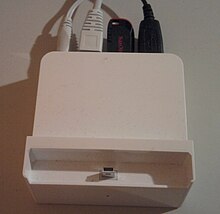A plug computer is a small-form-factor computer whose chassis contains the AC power plug, and thus plugs directly into the wall. Alternatively, the computer may resemble an AC adapter or a similarly small device. Plug computers are often configured for use in the home or office as compact computer.


Description
editPlug computers consist of a high-performance, low-power system-on-a-chip processor, with several I/O hardware ports (USB ports, Ethernet connectors, etc.). Most versions do not have provisions for connecting a display and are best suited to running media servers, back-up services, or file sharing and remote access functions; thus acting as a bridge between in-home protocols (such as Digital Living Network Alliance (DLNA) and Server Message Block (SMB)) and cloud-based services. There are, however, plug computer offerings that have analog VGA monitor and/or HDMI connectors, which, along with multiple USB ports, permit the use of a display, keyboard, and mouse, thus making them full-fledged, low-power alternatives to desktop and laptop computers. They typically run any of a number of Linux distributions.
Plug computers typically consume little power and are inexpensive.
History
editA number of other devices of this type began to appear at the 2009 Consumer Electronics Show.
- On January 6, 2009 CTERA Networks launched a device called CloudPlug that provides online backup at local disk speeds and overlays a file sharing service.[1] The device also transforms any external USB hard drive into a network-attached storage device.[2][3]
- On January 7, 2009, Cloud Engines unveiled the Pogoplug network access server.[4][5][6][7]
- On January 8, 2009, Axentra announced availability of their HipServ platform.[8]
- On February 23, 2009, Marvell Technology Group announced its plans to build a mini-industry around plug computers.[9][10]
- On August 19, 2009, CodeLathe announced availability of their TonidoPlug network access server.[11]
- On November 13, 2009 QuadAxis launched its plug computing device product line and development platform, featuring the QuadPlug and QuadPC and running QuadMix, a modified Linux.[12]
- On January 5, 2010, Iomega announced their iConnect network access server.[13]
- On January 7, 2010 Pbxnsip launched its plug computing device the sipJack running pbxnsip: an IP Communications platform.[14]
See also
edit- Classes of computers
- Computer appliance
- CuBox, a plug computer
- GuruPlug, a plug computer
- DreamPlug, a plug computer
- FreedomBox, an operating system
- Personal web server
- Print server
- Raspberry Pi, a single-board computer
- SheevaPlug, a plug computer
- Stick PC, a computer attached to and powered by a USB or HDMI plug
References
editExternal links
edit Media related to Plug computers at Wikimedia Commons
Media related to Plug computers at Wikimedia Commons
